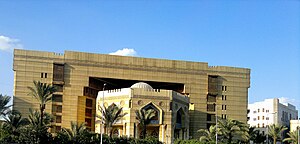| الأزهر الشريف | |
 Logo Logo | |
 Al-Azhar al-Sharif building Al-Azhar al-Sharif building | |
| Legal status | Organizations |
|---|---|
| Headquarters | Cairo, Egypt |
| Official language | Arabic |
| Grand Imam | Ahmed el-Tayeb |
| Budget | 19.9 Billion EGP |
| Website | www |
Al-Azhar al-Sharif is an Islamic scientific body and the largest religious institution in Egypt. Its headquarters is located in the building of the Sheikhdom of Al-Azhar in the center of the Egyptian capital, Cairo. The history of the establishment of the Al-Azhar Mosque dates back to the year 970 by the Fatimid Caliph Al-Muizz Li-Din Allah.
The Al-Azhar institution in its current form was reorganized according to Law No. 10 of 1911, amended by Law No. 32 and 33 of 1923, and then Law No. 103 of 1961, which stipulated that Al-Azhar is the major Islamic scientific body based on the preservation and study of Islamic heritage, and it has an independent moral personality, headed by it. It is led by the Grand Imam of al-Azhar, currently Ahmed el-Tayeb, and consists of several basic bodies.
Affiliated bodies
- Al-Azhar Senior Scholars Authority
- The Supreme Council of Al-Azhar
- Islamic Research Academy
- Al-Azhar Mosque
- Al-Azhar University
- City of Islamic Resurrections
- Azhar institutes
- Al-Azhar Library
- Al-Azhar Observatory for Combating Extremism.
Grand Imam of al-Azhar
The Grand Imam of al-Azhar is a prestigious and a prominent official title in Egypt. He is considered by some Muslims to be the highest authority in Sunni Islamic thought and Islamic jurisprudence and holds great influence on followers of the theological Ash'ari and Maturidi traditions worldwide. The Grand Imam heads the Al-Azhar Al Sharif, al-Azhar Mosque, and by extension al-Azhar University, and is responsible for official religious matters along with the Grand Mufti of Egypt.
Religious ideology

Historically, Al-Azhar had a membership that represented diverse opinions within Islam. It has a long tradition of teaching all four schools of Sunni Islamic jurisprudence (Hanafi, Maliki, Shafi, and Hanbali). The chief mufti of each school of thought acted as the dean, responsible for the teachers and students in that group. During the time of the Ottomans, the Hanafi dean came to hold a position as primus inter pares. It also had membership from the seven main Sufi orders. Al-Azhar has had an antagonistic relationship with Wahhabism. According to a 2011 report issued by the Carnegie Endowment for International Peace, Al Azhar is strongly Sufi in character:
Adherence to a Sufi order has long been standard for both professors and students in the al-Azhar mosque and university system. Although al-Azhar is not monolithic, its identity has been strongly associated with Sufism. The current Shaykh al-Azhar (rector of the school), Ahmed el-Tayeb, is a hereditary Sufi shaykh from Upper Egypt who has recently expressed his support for the formation of a world Sufi league; the former Grand Mufti of Egypt and senior al-Azhar scholar Ali Gomaa is also a highly respected Sufi master.
However, in the early 20th century, enlightened Modernist thinkers such as Muhammad Abduh led a reform of the curriculum, reintroducing a desire for legal reform through ijtihad. Subsequently, disputes were had between modernist intellectuals and traditionalists within al-Azhar. Al-Azhar now maintains a modernist position, advocating "Wasatiyya" (centrism), a reaction against the extreme textualism of many Wahhabi Salafi ideologues. Wasatiyya covers a range of thinkers, some of whom are liberal intellectuals with religious inclinations, preachers such as Yusuf al-Qaradawi and many members of the Muslim Brotherhood since the 2013 coup. However, Al-Azhar has taken a position against the brotherhood.
The nineteenth and current Grand Mufti of Egypt and Al Azhar scholar, is Shawki Ibrahim Abdel-Karim Allam. The university is opposed to overt liberal reform of Islam and issued a fatwa against the liberal Ibn Rushd-Goethe mosque in Berlin because it banned face-covering veils such as burqa and niqab on its premises while allowing women and men to pray together. The fatwa encompassed all present and future liberal mosques.
Photo gallery
See also
References
- Abou el Magd, Nadia (21 March 2010). "Mubarak appoints a new chief of Al Azhar". The National.
- "ننشر موازنة المؤسسات الدينية للعام المالي الجديد: 20 مليار جنيه للأزهر". elwatannews (in Arabic). 1 May 2021. Retrieved 11 October 2022.
- "قانون إعادة تنظيم الأزهر والهيئات التي يشملها رقم 103 لسنة 1961". Manshurat.org (in Arabic). 6 November 2016. Retrieved 11 October 2022.
- "about us". Islamic Research Academy. Retrieved 11 October 2022.
- Beattie 2000, p. 225
- Bennett 2005, p. 220
- ^ Jakob Skovgaard-Petersen (1997). Defining Islam for the Egyptian State: Muftis and Fatwas of the Dār Al-Iftā. BRILL. p. 100.
- Jadaliyya: "The Identity of Al-Azhar and Its Doctrine" by Ibrahim El-Houdaiby July 29, 2012
- Islamopedia: "Al-Azhar’s relations with other Sunni groups"
- Carnegie Endowment for International Peace" "Salafis and Sufis in Egypt" by Jonathon Brown December 2011, p 12
- Jung, Dietrich. "Islamic Reform and the Global Public Sphere." The Middle East and Globalization. Palgrave Macmillan, New York, 2012. 153-169.
- Gauvain, Richard. "SalafiSm in modern egypt: panacea or peSt?." Political Theology 11.6 (2010): 802-825.
- Hatina, Meir. "Historical legacy and the challenge of modernity in the Middle East: the case of Al-Azhar in Egypt." The Muslim World 93.1 (2003): 51.
- Brown, Nathan J. Post-revolutionary al-Azhar. Vol. 3. New York, NY: Carnegie Endowment for International Peace, 2011.
- Oltermann, Philip (2017-06-25). "Liberal Berlin mosque to stay open despite fatwa from Egypt". The Guardian. ISSN 0261-3077. Retrieved 2017-07-16.
Works cited
- Beattie, Kirk J. (2000). Egypt during the Sadat years. Palgrave Macmillan. ISBN 978-0-312-23246-7.
- Bennett, Clinton (2005). Muslims and modernity: an introduction to the issues and debates. Continuum International Publishing Group. ISBN 978-0-8264-5481-2.
External links
Portals:| Islamic Cairo | ||||||||||
|---|---|---|---|---|---|---|---|---|---|---|
| Northern part |
|  | ||||||||
| Southern part |
| |||||||||

